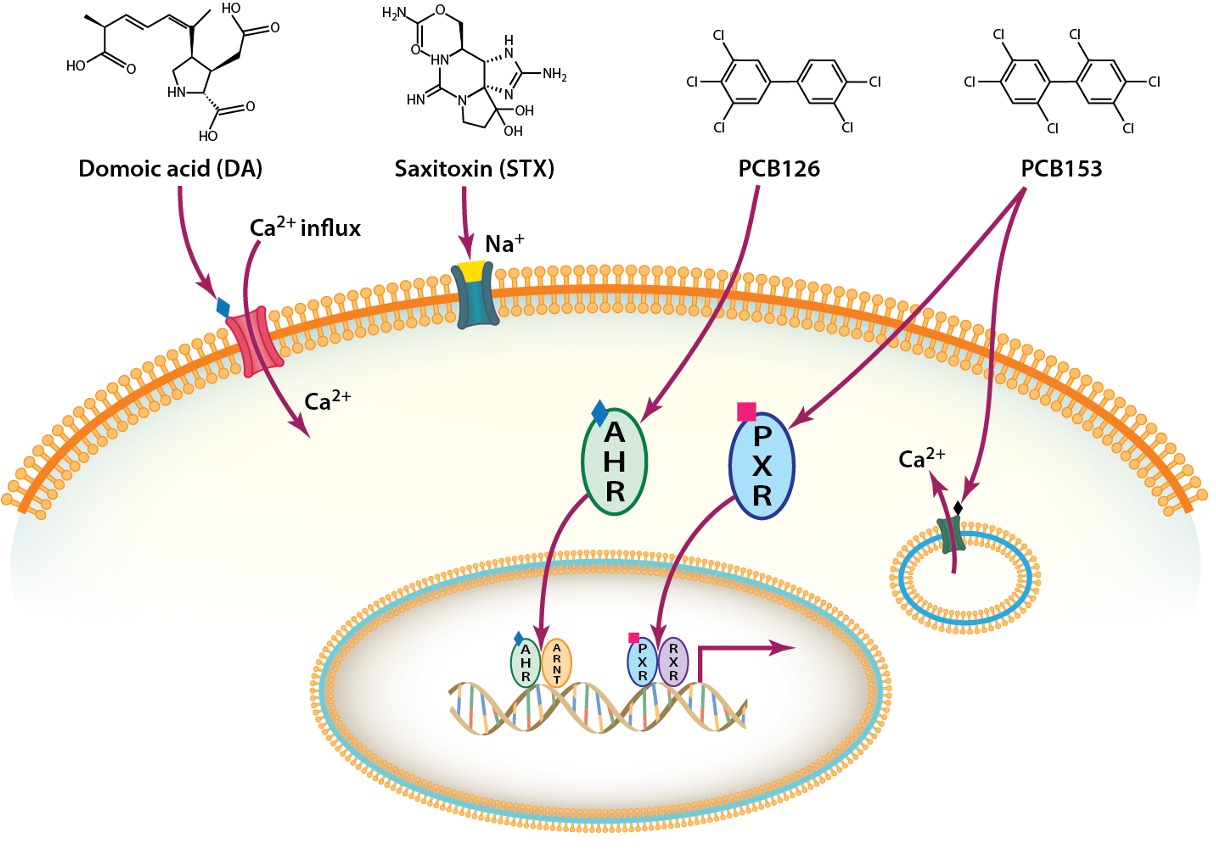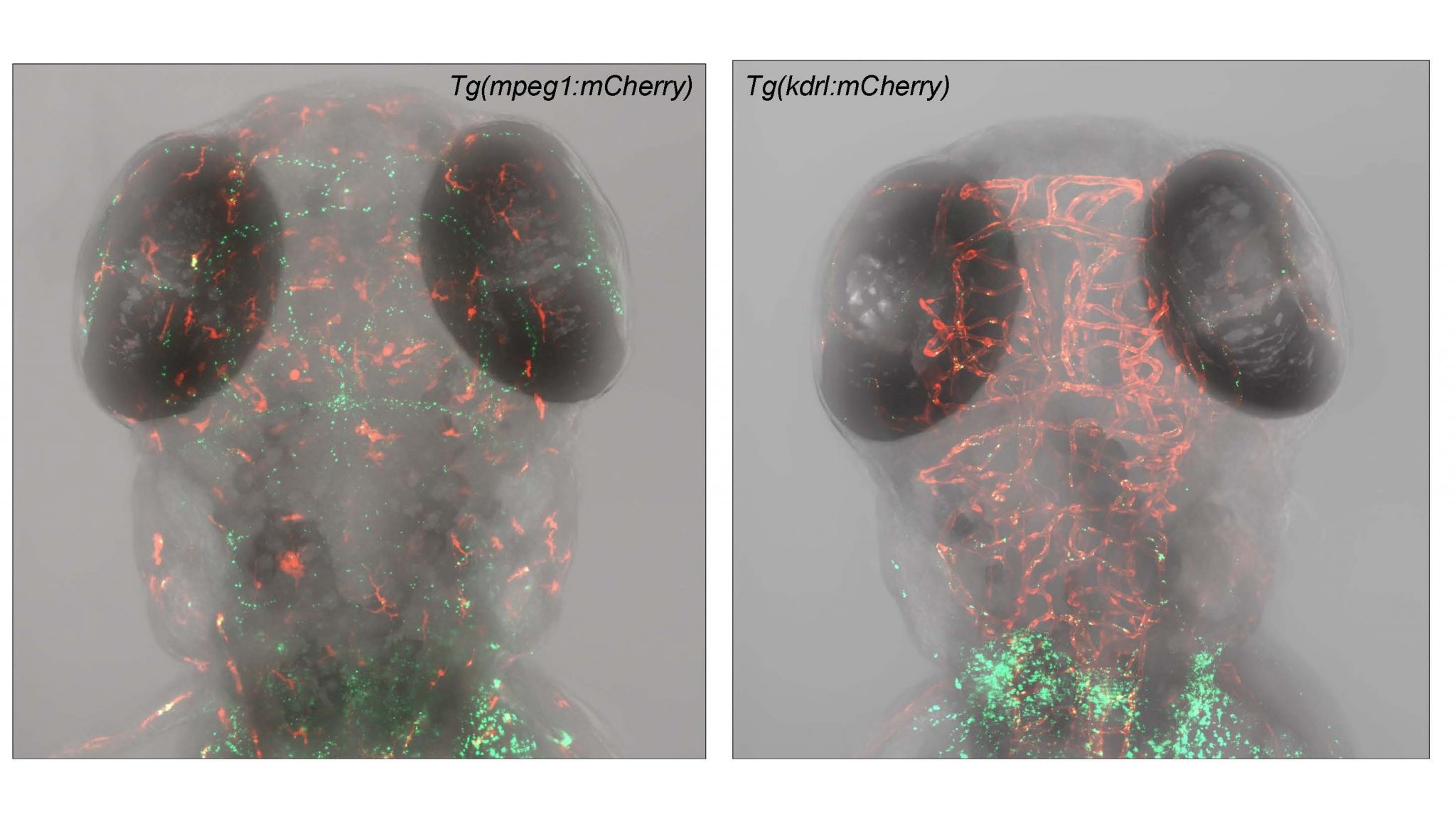Current Research
Cellular and molecular mechanisms underlying developmental exposure to harmful algal bloom toxins (Woods Hole Center for Oceans and Human Health; Funded jointly by NSF and NIH):
 This project aims to understand how toxins produced by HABs affect early development and long-term health. HAB toxins such as domoic acid, saxitoxin, and anatoxin-a are increasingly found in marine and freshwater environments and can accumulate in seafood. While current safety guidelines protect against acute poisoning in adults, much less is known about the subtle and long-term effects of repeated or low-level exposure, especially during vulnerable stages such as infancy, childhood, or pregnancy.
This project aims to understand how toxins produced by HABs affect early development and long-term health. HAB toxins such as domoic acid, saxitoxin, and anatoxin-a are increasingly found in marine and freshwater environments and can accumulate in seafood. While current safety guidelines protect against acute poisoning in adults, much less is known about the subtle and long-term effects of repeated or low-level exposure, especially during vulnerable stages such as infancy, childhood, or pregnancy.
Our work explores how exposure to HAB toxins during development alters the growth and function of specific brain cell types, including neurons and glial cells, which can lead to changes in behavior and neurological health later in life. To address these questions, we are currently using developing zebrafish, which allow us to study molecular, cellular, and behavioral changes in a whole organism. We will also conduct similar studies using human induced pluripotent stem cells, which enable us to examine how human neural cells respond to these toxins during differentiation and maturation. Using approaches such as single-cell RNA sequencing and high-resolution imaging, we identify which cell types are most sensitive to toxin exposure and how their gene activity is affected.
We are also investigating how environmental chemicals such as persistent organic pollutants (PCBs) influence or interact with HAB toxins to modify developmental outcomes. Finally, our aim is to integrate our experimental data with exposure modeling and climate projections to predict how environmental change may alter human exposure risks in the future.
Role of m6A RNA modifications in AHR-mediated developmental toxicity (NIH):
This project focuses on m⁶A (N6-methyladenosine), a common chemical mark on RNA that helps control how genes are expressed and how cells respond to their environment. We are studying how activation of the aryl hydrocarbon receptor (AHR), a key sensor of environmental pollutants affects genome-wide patterns of m⁶A RNA modifications. By combining immunoprecipitation-based enrichment of methylated RNA with nanopore sequencing, which allows us to read full-length RNA molecules and detect modifications directly, we can map how exposure to environmental chemicals reshapes the m⁶A landscape across different genes. Understanding these changes will reveal new molecular mechanisms by which early-life exposures disrupt normal development and contribute to long-term health effects. This research provides critical insight into how environmental pollutants influence gene regulation through RNA-level epigenetic processes.
Investigating the role of neuroinflammation in environmental exposure-induced anxiety disorders (NIH):
This project explores how early-life exposure to environmental contaminants affects the brain’s immune system and contributes to anxiety-related behaviors later in life. Our focus is on understanding how pollutants—such as polychlorinated biphenyls (PCBs) trigger neuroinflammation, a process involving the activation of glial cells that support and protect neurons. We combine advanced imaging, behavioral and transcriptomic (single-nucleus RNA sequencing) approaches to map how different brain cell types (both glia and neurons) respond to chemical exposure. These high-resolution analyses allow us to pinpoint specific molecular and cellular pathways disrupted by pollutants. By linking cellular changes in the brain to alterations in behavior, this research provides new insight into how environmental exposures during early life can shape neural and immune function, ultimately influencing mental health outcomes such as anxiety disorders.

Organismal Response to Climate Change (ORCC): Collaborative Research: Mechanisms Underpinning the Unusual, High CO2 Sensitivity of Sand Lances, Key Forage Fishes on the Northwest Atlantic Shelf (NSF) Chris Murray, lead PI:
This project uses modern experimental and molecular tools to understand exactly why sand lance embryos are so unusually sensitive and which genes and enzymes are responsible for this sensitivity. In addition, the work will compare a closely related sand lance species to find out whether the high climate sensitivity might be of general concern in this important group of forage fishes. This project combines innovative ecological, evolutionary, and genomic research to help society anticipate looming marine ecosystem changes in the 21st century.
Investigating the Role of Microplastics Exposure on the Gut Microbiome (WHOI Internal grant; Marine Microplastics Innovation Accelerator Award; In collaboration with Maria Pachiadaki):
Microplastics are well recognized as a threat to both environmental and human health. While microplastics are known to cause physical and chemical stress after ingestion, their effects on the gut microbiome, the community of microorganisms that supports digestion, immunity, and metabolism, remain poorly understood. Disruption of this delicate microbial balance has been linked to metabolic, immune, and neurological disorders, yet the influence of environmentally realistic microplastic exposures is still unclear.
Our research examines how exposure to microplastics, particularly polyethylene terephthalate (PET), affects the gut microbiota in aquatic models such as zebrafish (Danio rerio) and Atlantic killifish (Fundulus heteroclitus). We are exposing fish to environmentally relevant concentrations of microplastics and analyzing their intestinal microbial communities using amplicon and metagenomic sequencing. These approaches allow us to assess changes in microbial diversity, composition, and metabolic potential.
By linking shifts in the microbiome to physiological effects such as gut inflammation and altered barrier function, this work aims to uncover how microplastic pollution influences host health. The findings will improve our understanding of the biological consequences of microplastic exposure in aquatic organisms and help inform strategies to mitigate risks to ecosystems and human health.
